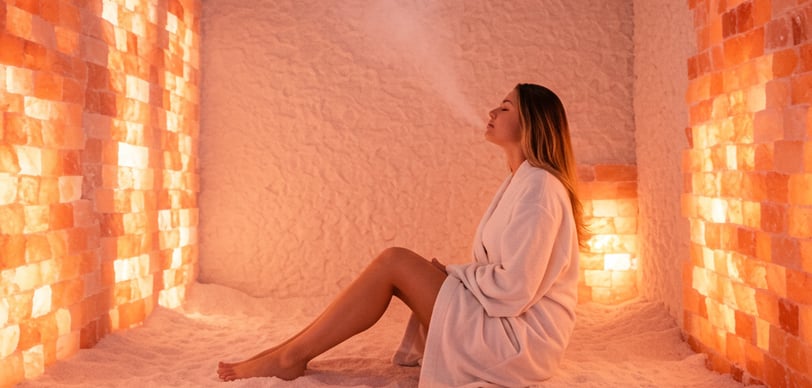Salt In The Air: Unpacking The Science Of Halotherapy
Hippocrates steamed it, miners breathed it, and now it’s in your spa. How and when did salt-breathing become a wellness trend?


Fast forward to 1838, and Polish physician Dr. Feliks Boczkowski opened the first health resort at the Wieliczka Salt Mine. Noticing salt miners rarely wheezed or coughed, he launched salt bath treatments, spotlighting salt’s potential beyond seasoning your stew [2]. This wasn’t a fluke—miners’ lungs seemed to thrive in those briny depths, hinting at something special in the air.
A century later, in 1949, German doctor Karl Hermann Spannagel studied how people hiding in salt caves during bombings emerged with better breathing. His work birthed speleotherapy—therapy via salt cave climates [3]. By 1964, Poland’s "Kinga Allergy Treatment Spa" at Wieliczka expanded this idea, while 1968 saw Ukraine’s Solotvyno Salt Mine open the world’s first speleo-hospital [4]. These milestones cemented salt’s rep as a respiratory ally, paving the way for today’s halotherapy boom.
How It Works—The Science of Salt in Your Lungs
Halotherapy works by delivering fine salt particles—micronized Himalayan pink salt or mined sodium chloride—straight to your lungs and skin. Here’s how it helps:
Mucus Melter: Salt’s mucolytic magic thins airway gunk, making it easier to cough up. Think of it as a natural decongestant for asthma or bronchitis sufferers [5].
Inflammation Fighter: Its anti-inflammatory properties might calm swollen airways, easing that tight-chest feeling [6].
Germ Buster: Salt’s chloride ions can form hypochlorous acid—a microbial assassin—potentially zapping bacteria and fungi in your lungs [7].
Airway Opener: Bronchodilation widens airways, letting you breathe deeper, a boon for COPD or allergy folks [8].
Skin Bonus: Those particles may exfoliate and hydrate skin, soothing eczema, psoriasis, or acne with antimicrobial flair [9].
The calming, ion-rich vibe of salt rooms might also chill you out, boosting mental well-being [10].
Dry vs. Wet—Two Ways to Get Salty
Halotherapy comes in two flavors, each with its own setup:
Dry Salt Therapy:
Dry salt therapy involves using a halogenerator to disperse micronized salt particles into a controlled environment, creating an aerosol-rich atmosphere for inhalation. Sessions typically last from around 30 to 60 minutes, during which individuals breathe in the salt-infused air.
Active systems continuously release salt particles, while passive setups replicate the natural conditions of salt caves without mechanical assistance. This method, widely adopted in modern wellness facilities, builds on the legacy of historic sites like Wieliczka, offering a targeted approach to respiratory and skin health support [11].
Wet Salt Therapy:
This is salt with a splash—gargling saline, soaking in a Himalayan pink salt bath, or steaming it for a soothing rinse. Hippocrates would approve; it’s hydrating and DIY-friendly. If you’ve ever steamed your face over a pot of saltwater, you’ve dipped into wet halotherapy without knowing it!
Both methods aim to deliver salt’s perks, just with different vibes—dry’s high-tech, wet’s homey.
The Hype Train—Why Salt’s Taking Over Wellness
Halotherapy’s gone global, fueled by a mix of history and hope. In Europe, physicians often favor it over early medication, while North American spas swiftly embrace salt rooms, propelled by a 3.2% CAGR (2021-2027) [12]. The anecdotal evidence is strong as patients laud fewer inhaler needs, clearer breathing, and healthier children.
While Ukraine’s Solotvyno and Poland’s Wieliczka stand as halotherapy icons, modern clinics in cities across the globe now deliver the experience, powered by 1980s halogenerator innovations[11]. Add in skin benefits like psoriasis relief and it’s no wonder that halotherapy’s a wellness darling.
The Science Check—What’s Proven, What’s Not
Scientific studies show promise: a 2014 review found dry-salt inhalers boosted lung function (FVC, FEV1) in COPD patients after months [8], while nebulized saline cut hospital stays for wheezing kids [13]. Historical miner data backs it up—less lung trouble underground isn’t just luck [2].
Compared to other salt varieties, Himalayan pink salt stands out as the superior choice due to its purity and mineral-rich profile, enhancing its respiratory and anti-inflammatory effects [14]. Processed salts are laden with anticaking agents and additives that dilute their purity, and varieties like sea salt may be contaminated with heavy metals and a high number of microplastics [15].
The sea, after all, is a dumping ground for industrial waste and filth, which ends up in food sources consumed by humans. Himalayan pink salt, on the other hand, is forged in ancient deposits, far removed from today’s polluted chaos. Side effects, like mild throat irritation or increased coughing, are rare [11]. Still, people with severe cases (think cancer, TB) and pregnant women should consult a physician beforehand.
Should You Try It?
Although criticized for a dearth of extensive scientific studies, halotherapy’s merits are backed by historical evidence. From Hippocrates, who championed saltwater inhalation for lung vitality, to Boczkowski, who marveled at salt miners’ resilience, and into the 20th century’s insights on salt’s inflammation-soothing, mucus-clearing powers, the evidence is there.
So if you’ve got mild asthma, allergies, or dry skin, or simply crave some calm—it’s certainly worth a shot. Check local wellness spots or Google “salt therapy near me” and you might be surprised who’s salty nearby. Spas charge $20-$50 per session, but wet therapy’s cheap: grab some Himalayan pink salt and steam it at home. For premium quality Himalayan pink salt, source it in bulk straight from us!
References
1. Hippocrates (ca. 460 BC). On Airs, Waters, and Places. Translated by Francis Adams.
2. Boczkowski, F. (1843). On the Healing Properties of Salt Mines. Wieliczka Salt Mine Archives.
3. Spannagel, K. H. (1950). "Speleotherapy Observations During WWII." German Medical Journal.
4. Chonka, Y. (2009). "Speleotherapy in Ukraine: History and Modern Use." Ukrainian Medical Journal.
5. Elkins, M. R., et al. (2006). "Hypertonic Saline Inhalation for Cystic Fibrosis." New England Journal of Medicine, 354(3), 229-240.
6. Horvath, T. (1980). "Effects of Salt Aerosols on Airway Inflammation." Respiratory Medicine, 74(2), 89-97.
7. Wark, P., & McDonald, V. (2008). "Nebulized Hypertonic Saline and Antimicrobial Effects." Thorax, 63(8), 672-678.
8. Rashleigh, R., et al. (2014). "Dry Salt Therapy for COPD: A Systematic Review." Respiratory Care, 59(5), 687-698.
9. Nissen, H. P., et al. (1994). "Salt Particles and Skin Health." Dermatology Research, 286(5), 321-327.
10. Hedman, J., et al. (2006). "Effects of Negative Ions on Mental Well-Being." Journal of Environmental Psychology, 26(2), 123-130.
11. Chervinskaya, A. V., & Zilber, N. A. (1995). "Halotherapy for Treatment of Respiratory Diseases." Journal of Aerosol Medicine, 8(3), 221-232.
12. Market Research Future. (2022). "Global Halotherapy Market Report 2021-2027."
13. Zhang, L., et al. (2015). "Nebulized Saline for Acute Bronchiolitis in Infants." Pediatrics, 135(4), e755-e764.
14. Khan, M. A., et al. (2017). "Mineral Composition of Himalayan Pink Salt." Journal of Food Science and Technology, 54(8), 2345-2350.
15. Kim, J. S., et al. (2018). "Microplastics in Sea Salt: A Global Concern." Environmental Science & Technology, 52(21), 12146-12153.






Centuries Ago: A Salty Legacy Began
Centuries ago, Hippocrates scribbled notes about saltwater’s healing powers, while Polish miners unknowingly inhaled their way to healthier lungs. Today, that legacy lives on in halotherapy—a practice blending ancient wisdom with modern flair, captivating wellness seekers worldwide. Derived from the Greek word hallas, meaning "salt," halotherapy isn’t just a buzzword; it’s a practice steeped in centuries of curiosity about salt’s healing powers. Let’s dive into its salty past, unpack how it works, and sift through the evidence to see if it’s worth a try.
From Ancient Caves To Modern Rooms—A Salty Timeline
Long before trendy wellness clinics, Hippocrates, the Greek "Father of Medicine," was writing on salt and seawater’s knack for healing around 460 BC. He urged patients with respiratory troubles to inhale steam from heated saltwater, believing it could loosen mucus and soothe airways—a primitive nod to what we’d call wet salt therapy today [1]. His focus on natural elements to balance the body set an early precedent.



